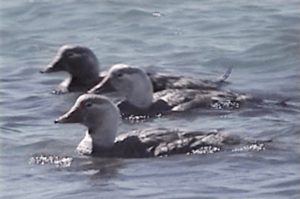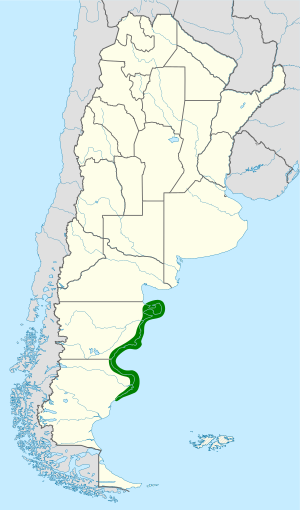Chubut steamer duck facts for kids
Quick facts for kids Chubut steamer duck |
|
|---|---|
 |
|
| Conservation status | |
| Scientific classification | |
| Genus: |
Tachyeres
|
| Species: |
leucocephalus
|
 |
|
The Chubut steamer duck (also called the white-headed flightless steamer duck) is a special type of duck that cannot fly. It lives only in Argentina. Its scientific name is Tachyeres leucocephalus.
This duck was only discovered in 1981, making it the most recently found species of steamer duck. It lives along a small part of the coast in southern Chubut and northern Santa Cruz Provinces. Steamer ducks often look very similar, which is why this one was not noticed sooner.
Contents
What Does It Look Like?
Male Chubut Steamer Ducks
Adult male Chubut steamer ducks have white heads. Their bills are bright yellow or orange with a black tip. Their feet and the webs between their toes are also yellow or orange, with black claws. The rest of their body is mostly grey, and their bellies are white. When a male duck is molting (shedding feathers), its bill becomes a duller yellow or orange.
Female Chubut Steamer Ducks
Adult female Chubut steamer ducks have brown heads and necks. They have a small white line that goes from behind their eye down to the front of their neck. Their bills are a greenish-yellow color. Young Chubut steamer ducks look very similar to the adult females.
Where Do They Live?
The Chubut steamer duck was first thought to live only on the southern coast of the Chubut province in Argentina. However, we now know they live in a larger area. Their home stretches from the southern part of the San Matías Gulf to a place called Islote Chato.
The most important places for these ducks are Bahía San Gregorio, Bahía Melo, and Caleta Malaspina. All three of these key areas are located in the San Jorge Gulf.
What Do They Eat?
Chubut steamer ducks mostly eat small sea creatures like molluscs (like snails and clams) and crustaceans (like crabs and shrimp). They get their food by diving underwater, tipping their bodies upside down, or dabbling (sifting through shallow water) just like many other ducks. They also sometimes look for food on land, but they always stay close to the coast.
How Do They Breed?
Breeding Season and Nests
The breeding season for Chubut steamer ducks is from October to February. They build their nests using grass, sticks, and other bits of material washed up by the tide. A typical nest holds about 5 to 6 eggs. Their nests can be found close together in groups or sometimes alone.
Nesting Locations
These ducks breed along 500 kilometers (about 310 miles) of coastline. This area stretches from the mouth of the Chubut River to the border between the Chubut and Santa Cruz provinces. It is estimated that there are about 3,700 pairs of these ducks that breed each year.
A study done between 2004 and 2006 looked at 292 km of mainland coastline and 59 km of island coastline. Out of 170 nests found, 169 were on islands or small islets, and only one was on the mainland. All the nests were found in bays or inlets where the water was shallow and protected from strong winds or big waves. Calm waters make it easier for the ducks to find food and for their chicks to swim.
Chubut steamer ducks build their nests on the ground. They prefer nesting spots that have at least 1 square meter (about 11 square feet) of shrub cover. Nesting on islands helps protect their young from predators that fly in the air (thanks to the shrubs) and from land predators that cannot swim to the island.
What Dangers Do They Face?
Chubut steamer ducks face many threats. These include oil exploration, their homes being destroyed, predators, and invasive species. Other dangers come from guano (bird droppings), large seaweeds, and people collecting their eggs.
Oil Spills
In the last 30 years, there have been three major oil spills that harmed the ducks' breeding areas. The ducks themselves were covered in oil, and the ground where they build their nests became polluted.
Invasive Species
Three main invasive species affect the Chubut steamer ducks. These are the Green Crab, Wakame (a type of Asian kelp), and the Acorn Barnacle. These species don't directly harm the ducks, but they change the environment where the ducks live, making it harder for them to survive.
Predators
Some animals hunt Chubut steamer ducks underwater. These include the South American sea lion and the Killer whale.
Two birds are often seen eating the eggs of Chubut steamer ducks: the Kelp gull and the Crested caracara. People collecting eggs has been reported, but it is not as big a threat as the others.
How Do They Escape Danger?
Since Chubut steamer ducks cannot fly, they have special ways to escape predators. They can swim, dive, or "steam." Steaming is a unique and very fast way for these flightless birds to move on the water. When they steam, they use their wings like oars and their feet to push water, creating a lot of movement. They can reach speeds of up to 24 kilometers per hour (about 15 miles per hour) when steaming!
What Is Their Future?
When the Chubut steamer duck was first discovered in 1988, it was thought to be safe because its population seemed stable. However, over the years, its conservation status has changed.
- In 1994, it was listed as "lower risk/near threatened."
- In 2004, it became "near threatened."
- Finally, in 2012, it was listed as "vulnerable," meaning its population is decreasing.
The total number of Chubut steamer ducks is estimated to be between 5,300 and 5,600 individuals. About 3,400 to 3,700 of these are adult ducks that can breed.
Good news is that almost half of their population (46%) is protected by the Interjurisdictional Marine Park in the San Jorge Gulf. Also, the UNESCO Biosphere Reserve has included the duck's breeding areas in its protection program.
There are plans to keep oil tankers and other large ships away from the ducks' living areas. There are also proposals to reduce human disturbance and coastal development in their breeding grounds. These efforts aim to help protect the Chubut steamer duck for the future.
Images for kids
See also
 In Spanish: Pato vapor cabeza blanca para niños
In Spanish: Pato vapor cabeza blanca para niños




